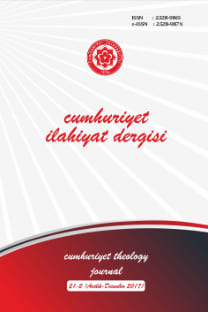Bâtınî Ekolleri Anlamada Anahtar Bir Kavram: Ezılle/Gölgeler Nazariyesi
A Key Concept in Understanding of Esoteric Sects: The Theory of Shadows
Esotericism, the Theory of Shadows, Aẓilla, Islamic Sects, Ismailism, Nusayrism, Yazidism Druze,
___
- Aster, Ernst Von. İlk ve Orta Çağ Felsefesi Tarihi. trc. Vural Okur. İstanbul: Arşiv Yayınları, 1999.
- Avcu, Ali. Karmatîliğin Doğuşu ve Gelişim Süreci. Sivas: Cumhuriyet Üniversitesi Yayınları, 2011.
- Avcu, Ali. Horasan-Maveraünnehir'de İsmailîlik. Ankara: Asitan Kitap, 2014.
- el-Bağdâdî, Ebû Mansûr Abdulkkâhir. Mezhepler Arasındaki Farklar. trc. Ethem Ruhi Fığlalı. Ankara: Türkiye Diyanet Vakfı Yayınları, 1991.
- Bağlıoğlu, Ahmet. İnanç Esasları Açısından Dürzîlik. Ankara: Ankara Okulu, 2004.
- Bar-Aasher, Meir ve M.-Kofsky, Aryeh. "Ali b. Ebî Tâlib'in İlahi Vasıflarına Dair Nusayrî Öğretisi ve VII/XIII. Yüzyıldan Kalma Yayımlanmamış Bir Risâleye Göre Nusayrî Üçlemesi". Tarihten Teolojiye İslam İnançlarında Hz. Ali içerisinde, haz. Ahmet Yaşar Ocak, Ankara: Türk Tarih Kurumu Yayınları, 2005.
- Benli, Yusuf. "Hicrî II. Asırda Kûfe Merkezli Şii Nitelikli Gulât Hareketleri". Doktora Tezi, Harran Üniversitesi, 1999.
- Bozan, Metin. "Şeyh 'Adî'siz Yezidîlik: Yezidîler'in Adî b. Müsâfir Algısında Ya- şanan Farklılaşmalar", Ankara Üniversitesi İlahiyat Fakültesi Dergisi 53, sy. 2 (2012), 23-41.
- Câbirî, Muhammed Âbid. Arap-İslâm Kültürünün Akıl Yapısı. trc. Burhan KöroğluHasan Kacak-Ekrem Demirli, İstanbul: Kitabevi,1999.
- Çakar, Mehmet Sait. Yezidîler. Ankara: Vadi Yayınları, 2007.
- el-Cu'fî, Mufaddal b. Ömer. Kitâbu'l-heft ve'l-ezılle. thk. Ârif Tâmir. Beyrut: Dâru Mektebeti'l-Hilâl, t.y.
- Daftary, Farhad. İsmaililer Tarih ve Kuram. trc. Ercüment Özkaya. Ankara: Rastlantı Yayınları, 2001.
- ed-Deylemî, Muhammed b. Hasan (8./14. asrın başları). Beyânu mezâhibi'l-Bâtı- niyye ve butlânihî. Kavâidu 'akâidi Âli Muhammed içinde, thk. R. Strothmann, Riyad: t.y.
- Dürzi Risaleleri. er-Risâletü'l-mevsûme bi sebebi'l-esbâb. Ürdün Üniversitesi, nr. 568/1, 585/134, 588/411.
- Dürzi Risaleleri. Kitâbun fîhi taksîmü'l-ulûm ve isbâtu'l-hakk ve keşfü'l-meknûn. Ürdün Üniversitesi, 569/1, 570/2, 573/19, 576/27, 581/127, 587/154.
- Dürzi Risaleleri. er-risâletü'l-mevsûme bi'r-rızâ ve't-teslîm. Ürdün Üniversitesi, 569/1, 570/2, 571-2, 574/27, 575/27, 575/27, 577/29, 581/127, 587/154.
- Dürzi Risaleleri. er-Risâletü't-tenzîhî ilâ vemâ'ati'l-muvahhidîn. Ürdün Üniversitesi, 569/1, 570/2, 571/2, 573/19, 574/27, 575/27, 576/27, 577/29, 581/127, 587/154.
- Evren, Ahi. Tebsıratü'l-mübtedî ve tezkiratü'l-muhtedî. trc. Mikail Bayram. Ahi Evren Tasavvufî Düşüncenin Esasları içerisinde, Ankara: Türkiye Diyanet Vakfı Yayınları, 2006.
- el-Eş'arî, Ebû'l-Hasen. Makâlâtu'l-islâmiyyîn ve ihtilâfu'l-musallîn. trc. Mehmet Dalkılıç-Ömer Aydın. İstanbul: Kabalcı Yayınları, 2005.
- Floramo, Giovanni. Gnostisizm Tarihi. trc. Selma Aygül Baş-Bilal Baş. İstanbul: Litera Yayınları, 2005.
- Friedman, Yaron. The Nusayrî 'Alawîs. Leiden-Boston: E. J. Brill, 2010.
- Gazâlî, Ebû Hâmid Muhammed b. Muhammed. Bâtınîliğin İçyüzü. trc. Avni İlhan. Ankara: Türkiye Diyanet Vakfı Yayınları, 1993.
- Gündüz, Şinasi. Anadolu'da Paganizm Antik Dönemde Harran ve Urfa. Ankara: Ankara Okulu, 2005.
- Gündüz, Şinasi. Sâbiîler Son Gnostikler. Ankara: Vadi Yayınları, 1999.
- Hermes. Corpus Hermeticum. trc. Muhammed Âbid el-Câbirî. Arap İslam Kültürü- nün Akıl Yapısı içerisinde, 343-350, İstanbul: Kitabevi, 2001.
- İbn Teymiyye, Takiyyuddîn Ahmed b. Abdülhalîm. Minhâcu's-sünneti'n-nebeviyye. thk. Muhammed Reşad Sâlim. y. y.: 1986.
- Kadı Nu'mân b. Muhammed. Esâsu't-te'vîl. thk. Arif Tâmir. Beyrut: 1960.
- el-Kâdî, Vedat. "Keysaniyye'ye Özel Referansla İslam Kaynaklarında Gulât Teriminin Gelişimi". trc. Yusuf Benli. Dinbilimleri Akademik Araştırma Dergisi 7, sy. 2 (2017), 241-276.
- el-Kirmanî, Hamîdüddîn Ahmed b. Abdullah. Râhatu'l-'akl. thk. Mustafa Gâlib. Beyrut: 1983.
- Kitâbu'l-Cilve, trc. Mehmet Aydın, Belleten 52, sy. 202, (1988), 57-61.
- Kitâbu'l-Mecmû'. trc. Mustafa Öz, İslam Mezhepleri Tarihi içerisinde, İstanbul: Ensar Yayınları, 2012, 604-615.
- Konuk, Ahmed Avni. Fusûsu'l-Hikem Tercüme ve Şerhi. haz. Mustafa Tahralı-Sel- çuk Eraydın. İstanbul: Marmara Üniversitesi İlahiyat Fakültesi Yayınları, 1999.
- el-Kummî, Sa'd b. Abdillah el-Eş'arî (300/912) ve en-Nevbahtî, Hasan b. Mûsâ (302/915'li yıllar). Şiî Fırkalar Kitâbu'l-makâlât ve'l-fırak-fıraku'ş-şî'a. trc. Hasan Onat-Sabri Hizmetli-Sönmez Kutlu-Ramazan Şimşek, Ankara: Ankara Okulu Yayınları, 2004.
- Massignon, Louis. "Nusayriler". İslam Ansiklopedisi, sy. 9, 365-370, İstanbul: Milli Eğitim Bakanlığı Yayınları, 1964.
- Meşkûr, Cevad. Mezhepler Tarihi Sözlüğü. trc. Mahfuz Söylemez-Mehmet ÜmitCemil Hakyemez, Ankara: Ankara Okulu Yayınları, 2001.
- Mushaf-ı Reş. trc. Mehmet Aydın, Belleten 52, sy. 202, (1988), 61-63.
- Öz, Mustafa. Başlangıcından Günümüze İslam Mezhepleri Tarihi. İstanbul: Ensar Yayınları, 2011.
- Öz, Mustafa. Mezhepler Tarihi ve Terimleri Sözlüğü. İstanbul: Ensar Neşriyat, 2012.
- Öztürk, Mustafa. Kur'an ve Aşırı Yorum. Ankara: Kitâbiyât, 2003.
- es-Sicistanî, Ebû Ya'kûb. Kitâbu'l-iftihâr. thk. Mustafa Gâlib. Beyrut: Dâru'l-Endelüs, 1980.
- Şenzeybek, Aytekin. "Resâilü'l-Hikme'ye Göre Dürzi İnanç Esasları". Doktora Tezi, Selçuk Üniversitesi, 2008.
- Tan, Muzaffer. "Geçmişten Günümüze Dürzîlik". e-Makâlât 5, sy. 2 (2012), 61-82. Erişim 26 Ekim 2016, http://emakalat.com/article/view/1085000116/1085000100.
- Turan, Ahmet. "Yezidî İnanç ve İbadetleri". Ondokuz Mayıs Üniversitesi İlahiyat Fakültesi Dergisi, 1 (Samsun 1986).
- Uyar, Mazlum. "Nusayrîlik". İslam Mezhepleri Tarihi El Kitabı içerisinde, ed. Hasan Onat-Sönmez Kutlu, Ankara: Grafiker Yayınları, 2012.
- Wasserstrom, Steve. "The Moving Finger Writes: Mughîra b. Sa'îd's Islamic Gnosis and the Myths of Its Rejektion". History of Religion, 25, nr. 1, (1985): 1- 29.
- Weber, Alfred. Felsefe Tarihi. trc. Vehbi Eralp, İstanbul: Sosyal Yayınları, 1998.
- ISSN: 2528-9861
- Yayın Aralığı: 2
- Başlangıç: 1996
- Yayıncı: Cumhuriyet Üniversitesi İlahiyat Fakültesi
Kur’an’da Genel Anlamlı Bir Kelime: Nimet
Osmanlı Tekke Mutfak Kültürü ve Mecmuâ-i Fevâid
Modern Dönem Nesih Tartışmaları ve İbn Kesîr’in Neshe Yaklaşımı
Bir Kaidenin Serencamı: Hâcet Umumi Olsun Hususi Olsun Zaruret Menzilesine Tenzil Olunur
Bâtınî Ekolleri Anlamada Anahtar Bir Kavram: Ezılle/Gölgeler Nazariyesi
el-Müddessir 11-26. Âyetlerine Sosyal Psikoloji Teorileri Çerçevesinde Bir Bakış
Şeyh Hâlid Efendi’nin Divan’ında İnsan-ı Kâmil Düşüncesi
Osmanlı’da Tefsir Dersi Gelenekleri, Kur’an-Tefsir Akademisi, İstanbul 07-09 Ekim 2016.
